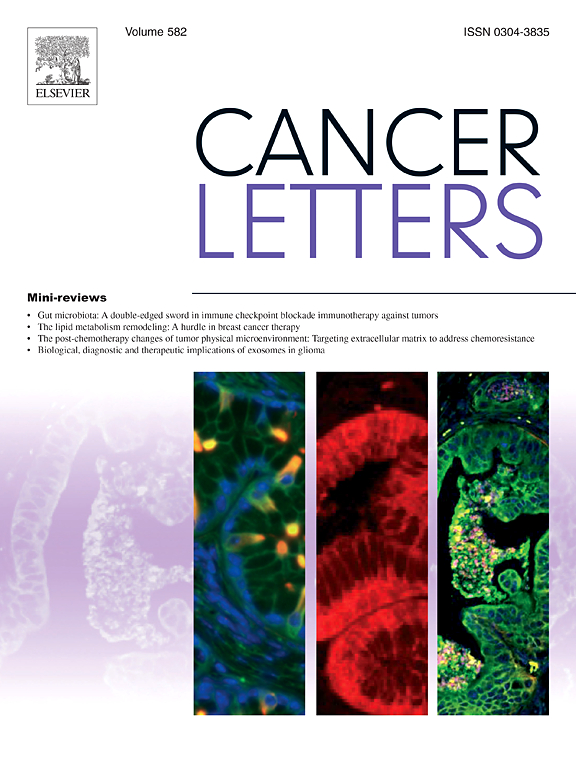Mechanisms and therapeutic implications of glioma-neuron interactions
IF 10.1
1区 医学
Q1 ONCOLOGY
引用次数: 0
Abstract
Glioma is the most common type of primary brain tumor and is almost always fatal. The challenge to develop more effective treatments lies in its high invasiveness and solid intratumoral heterogeneity, as well as its insensitivity to traditional radiotherapy and chemotherapy. With the rise of cancer neuroscience, mounting evidence has uncovered a multi-layered and dynamically complex network of communication between glioma cells and neurons which has given us new insights into tumor progression. The nervous system is now recognized as not merely a passive victim of tumor invasion, but as an active modulator and perhaps even driver of glioma progression. In this review, we systematically summarize the interaction of glioma with neuron mechanisms, including synaptic, electrophysiological, paracrine, metabolic, and neurotransmitter-related pathways. In addition, we investigate the extent to which these interactions are associated with gliomas and reveal their potential as therapeutic targets, thereby offering a theoretical foundation and new strategies for the precision treatment of glioma. Taken together, the cross-talk between gliomas and neurons is a dynamic, multi-level, multi-pathway co-regulated network system. Further exploration of this network may promote transformation from a tumor-focused to a tumor-neuron network-based therapeutic plan and provide new prospects for precision medicine.

胶质瘤-神经元相互作用的机制及其治疗意义。
胶质瘤是最常见的原发性脑肿瘤,几乎总是致命的。开发更有效的治疗方法的挑战在于其高侵袭性和肿瘤内的固体异质性,以及对传统放疗和化疗的不敏感性。随着癌症神经科学的兴起,越来越多的证据揭示了神经胶质瘤细胞和神经元之间多层次、动态复杂的通讯网络,这为我们了解肿瘤的进展提供了新的见解。神经系统现在被认为不仅是肿瘤侵袭的被动受害者,而且是神经胶质瘤进展的主动调节剂,甚至可能是驱动者。在这篇综述中,我们系统地总结了胶质瘤与神经元机制的相互作用,包括突触、电生理、旁分泌、代谢和神经递质相关途径。此外,我们还研究了这些相互作用与胶质瘤的关联程度,并揭示了它们作为治疗靶点的潜力,从而为胶质瘤的精确治疗提供了理论基础和新的策略。综上所述,神经胶质瘤与神经元之间的相互作用是一个动态的、多层次的、多通路的共调控网络系统。对该网络的进一步探索,将促进肿瘤为中心的治疗方案向肿瘤神经元网络为基础的治疗方案的转变,为精准医疗提供新的前景。
本文章由计算机程序翻译,如有差异,请以英文原文为准。
求助全文
约1分钟内获得全文
求助全文
来源期刊

Cancer letters
医学-肿瘤学
CiteScore
17.70
自引率
2.10%
发文量
427
审稿时长
15 days
期刊介绍:
Cancer Letters is a reputable international journal that serves as a platform for significant and original contributions in cancer research. The journal welcomes both full-length articles and Mini Reviews in the wide-ranging field of basic and translational oncology. Furthermore, it frequently presents Special Issues that shed light on current and topical areas in cancer research.
Cancer Letters is highly interested in various fundamental aspects that can cater to a diverse readership. These areas include the molecular genetics and cell biology of cancer, radiation biology, molecular pathology, hormones and cancer, viral oncology, metastasis, and chemoprevention. The journal actively focuses on experimental therapeutics, particularly the advancement of targeted therapies for personalized cancer medicine, such as metronomic chemotherapy.
By publishing groundbreaking research and promoting advancements in cancer treatments, Cancer Letters aims to actively contribute to the fight against cancer and the improvement of patient outcomes.
 求助内容:
求助内容: 应助结果提醒方式:
应助结果提醒方式:


